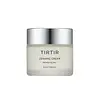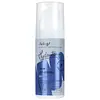What's inside
What's inside
 Key Ingredients
Key Ingredients

 Benefits
Benefits

 Concerns
Concerns

 Ingredients Side-by-side
Ingredients Side-by-side

Water
Skin ConditioningGlycerin
HumectantOlea Europaea Fruit Oil
MaskingButylene Glycol
HumectantMacadamia Ternifolia Seed Oil
EmollientCyclopentasiloxane
EmollientHamamelis Virginiana Extract
AntiseborrhoeicBeeswax
Emulsion StabilisingCetearyl Alcohol
EmollientCetyl Ethylhexanoate
EmollientCyclohexasiloxane
EmollientIsopropyl Myristate
EmollientPolyglyceryl-3 Methylglucose Distearate
EmulsifyingPolysorbate 60
EmulsifyingStearic Acid
CleansingPEG-100 Stearate
Glyceryl Stearate
EmollientDimethiconol
EmollientSodium Polyacrylate
Absorbent1,2-Hexanediol
Skin ConditioningCaprylyl Glycol
EmollientButyrospermum Parkii Butter
Skin ConditioningCamellia Sinensis Leaf Extract
AntimicrobialRosmarinus Officinalis Leaf Extract
AntimicrobialChamomilla Recutita Flower Extract
MaskingCentella Asiatica Extract
CleansingGlycyrrhiza Glabra Root Extract
BleachingPolygonum Cuspidatum Root Extract
AntioxidantScutellaria Baicalensis Root Extract
AstringentIllicium Verum Fruit Extract
PerfumingDisodium EDTA
Betaine
HumectantAllantoin
Skin ConditioningTrehalose
HumectantPolysorbate 20
EmulsifyingPolyglutamic Acid
Skin ConditioningXylitol
HumectantCeramide NP
Skin ConditioningWater, Glycerin, Olea Europaea Fruit Oil, Butylene Glycol, Macadamia Ternifolia Seed Oil, Cyclopentasiloxane, Hamamelis Virginiana Extract, Beeswax, Cetearyl Alcohol, Cetyl Ethylhexanoate, Cyclohexasiloxane, Isopropyl Myristate, Polyglyceryl-3 Methylglucose Distearate, Polysorbate 60, Stearic Acid, PEG-100 Stearate, Glyceryl Stearate, Dimethiconol, Sodium Polyacrylate, 1,2-Hexanediol, Caprylyl Glycol, Butyrospermum Parkii Butter, Camellia Sinensis Leaf Extract, Rosmarinus Officinalis Leaf Extract, Chamomilla Recutita Flower Extract, Centella Asiatica Extract, Glycyrrhiza Glabra Root Extract, Polygonum Cuspidatum Root Extract, Scutellaria Baicalensis Root Extract, Illicium Verum Fruit Extract, Disodium EDTA, Betaine, Allantoin, Trehalose, Polysorbate 20, Polyglutamic Acid, Xylitol, Ceramide NP
Water
Skin ConditioningCaprylic/Capric Triglyceride
MaskingDicaprylyl Carbonate
EmollientPropanediol
SolventGlycerin
HumectantSodium Acrylates Copolymer
Lecithin
EmollientSorbitol
HumectantLaminaria Digitata Extract
Skin ProtectingXanthan Gum
EmulsifyingDiatomaceous Earth
AbrasiveCaprylyl Glycol
EmollientGlyceryl Caprylate
EmollientAloe Barbadensis Leaf Juice
Skin ConditioningTocopheryl Acetate
AntioxidantDisodium EDTA
Citric Acid
BufferingPotassium Sorbate
PreservativeSodium Benzoate
MaskingPhenoxyethanol
PreservativeEthylhexylglycerin
Skin ConditioningParfum
MaskingCI 42090
Cosmetic ColorantWater, Caprylic/Capric Triglyceride, Dicaprylyl Carbonate, Propanediol, Glycerin, Sodium Acrylates Copolymer, Lecithin, Sorbitol, Laminaria Digitata Extract, Xanthan Gum, Diatomaceous Earth, Caprylyl Glycol, Glyceryl Caprylate, Aloe Barbadensis Leaf Juice, Tocopheryl Acetate, Disodium EDTA, Citric Acid, Potassium Sorbate, Sodium Benzoate, Phenoxyethanol, Ethylhexylglycerin, Parfum, CI 42090
 Reviews
Reviews

Ingredients Explained
These ingredients are found in both products.
Ingredients higher up in an ingredient list are typically present in a larger amount.
Caprylyl Glycol is a humectant and emollient, meaning it attracts and preserves moisture.
It is a common ingredient in many products, especially those designed to hydrate skin. The primary benefits are retaining moisture, skin softening, and promoting a healthy skin barrier.
Though Caprylyl Glycol is an alcohol derived from fatty acids, it is not the kind that can dry out skin.
This ingredient is also used as a preservative to extend the life of products. It has slight antimicrobial properties.
Learn more about Caprylyl GlycolDisodium EDTA plays a role in making products more stable by aiding other preservatives.
It is a chelating agent, meaning it neutralizes metal ions that may be found in a product.
Disodium EDTA is a salt of edetic acid and is found to be safe in cosmetic ingredients.
Learn more about Disodium EDTAGlycerin is already naturally found in your skin. It helps moisturize and protect your skin.
A study from 2016 found glycerin to be more effective as a humectant than AHAs and hyaluronic acid.
As a humectant, it helps the skin stay hydrated by pulling moisture to your skin. The low molecular weight of glycerin allows it to pull moisture into the deeper layers of your skin.
Hydrated skin improves your skin barrier; Your skin barrier helps protect against irritants and bacteria.
Glycerin has also been found to have antimicrobial and antiviral properties. Due to these properties, glycerin is often used in wound and burn treatments.
In cosmetics, glycerin is usually derived from plants such as soybean or palm. However, it can also be sourced from animals, such as tallow or animal fat.
This ingredient is organic, colorless, odorless, and non-toxic.
Glycerin is the name for this ingredient in American English. British English uses Glycerol/Glycerine.
Learn more about GlycerinWater. It's the most common cosmetic ingredient of all. You'll usually see it at the top of ingredient lists, meaning that it makes up the largest part of the product.
So why is it so popular? Water most often acts as a solvent - this means that it helps dissolve other ingredients into the formulation.
You'll also recognize water as that liquid we all need to stay alive. If you see this, drink a glass of water. Stay hydrated!
Learn more about Water